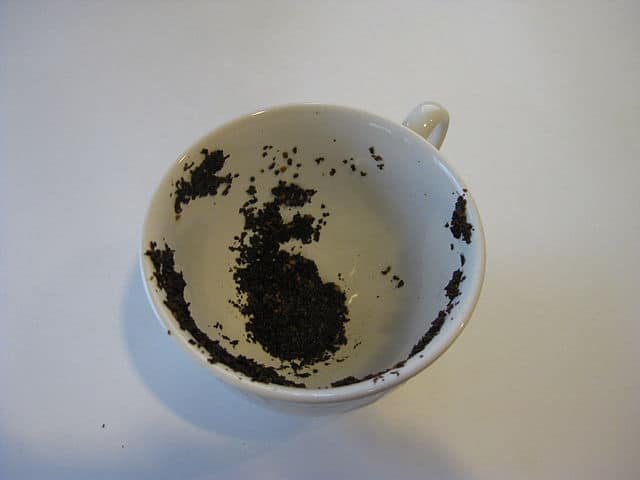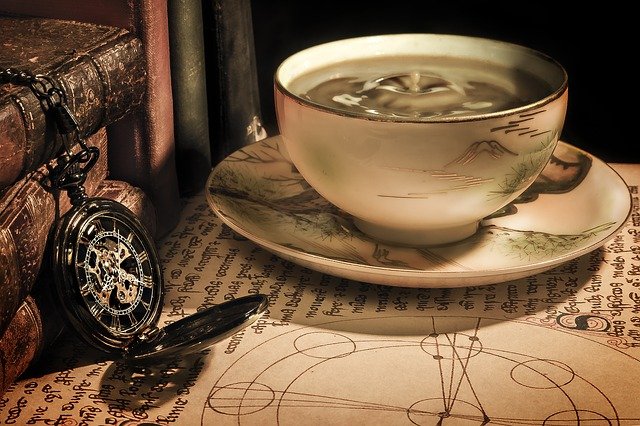
Tea is a historically fascinating drink. You could unironically write several books on the things that tea has been through. Just covering the way tea has developed over the centuries could fill a book by itself. That isn’t counting the historical events that tea was part of.
It doesn’t even have the common courtesy to just be a regular thing that people drink. Tea is a cultural tool for astrological divination. For those who don’t know what that means, you can read tea leaves to tell the future. That’s essentially tasseography.
Knowledge of how to read tea leaves can vary depending on who you learn it from. Generally though, you direct your intentions and energy to exercise your intuition. That way, you can divine different symbols and patterns in the tea leaves.
Tasseography also has its own history. As different civilizations picked up on tea and started drinking, they also told futures with the tea leaves. Teabags weren’t quite the thing yet. People still mixed their tea with crushed leaves or even just outright boiled the leaves and drank the water.
The study of tasseography confused many then as it does now. However, it’s not that hard to get started and learn the art of reading tea leaves. Read on and learn how to start your studies into reading your future in your tea leaves now!
Reading Tea Leaves
Starting off your tea leaves reading has to start with the obvious: a cup of tea! Brew up a cup and enjoy it. No rush; just drink your tea. Have a chat with your friends online, even. There’s a pandemic out and about, so take your time with that cup of tea. It will be your tasseography cup.
Like any other kind of divination, tasseography requires you to direct your energy. It’s convenient too, since it’s much less structural than tarot readings. You get to lower your expenses on an extravagant crystal collection too.
If you want to start becoming a tasseographer, you can do a tea leaf reading at home. That’s the beauty of tasseography; you can easily start your own divination practice at home. Don’t let the lack of popularity in tasseography discourage you.
Other divination practices like tarot and regular astrology are more popular. However, tasseography has its own charms. Like the fact it’s much more affordable and convenient to practice.
Learning to identify symbols and decode messages in your tea leaves is simple enough to learn. The way that they shape up after you drink the cup and configure themselves is how you’ll tell the future. Though simple, the results can be profound and many continue to practice it long after they start.
The History of Tea
As mentioned before, the story of tea is a long and checkered one. Most historians agree that the origin of tea, like many things, began in China. Chinese legend holds that the creation of tea was quite the Newtonian accident.
In 2737 BC, the emperor Shen Nung was relaxing beneath a camellia tree. He wanted a drink, so his servant boiled him some water. Quite by chance, some of the camellia leaves fell into his water. On top of being emperor, Shen Nung was also a skilled herbalist. He tried the strange new infusion to his water his servant accidentally made.

Of course, this is just the legend told in China. Regardless of whether there’s any real history behind it, it’s certainly a fact that China’s been drinking tea for centuries. Long before any Western nations even heard of tea, there’s proof they’ve been drinking it since the Han Dynasty. That’s 206 BC.
Despite Han teapots being around since 206 BC, it wasn’t until 618 BC that China established it as their national drink. The Tang dynasty established it late in the 8th century when a writer named Lu Yu wrote an entire book about tea. It was the Ch’a Ching or the Tea Classic.
Shortly after that, China introduced tea to foreign neighbors like Japan. This happened because Japanese Buddhist monks had travelled to China to study. Tea became such a vital part of Japanese culture that they developed the chanoyu. Chanoyu means Tea Ceremony, and it was all about making the perfect cup of tea.
The History of Tasseography
Now we know the history of tea. It’s time to learn the history of how we learned to read tea leaves. Obviously, it has origins in Asia, but it also has roots in the Middle East and Ancient Greece. However, Middle Eastern folk used the dregs of their coffee rather than tea leaves.
Modern tea leaf reading as we know it really started in the 17th century when China introduced tea to Europe. Loose leaf tea used to be an upper class product. But the study of reading the leaves emerged when the drink became more available.
People saw that they could see their conversations and lives in the tea leaves. Its development arose also when people saw they often discussed their lives over a cup of tea. Such things weren’t so different from seeing shapes in the clouds.
Romans spread the practice throughout Europe; it reached a point of door-to-door readings. By the mid-1800s, Romans had regularly incorporated tea culture. They even had tea rooms and parlors with such readings for guests.
Fifty years later, the US started doing the same. Tea became more popular over the years. After WWI, American women even opened their own tea parlors. Serving light snacks and leaf readings increased the tea community experience in America.
From there, women passed down the art of tea reading from generation to generation. While some hold that there’s a level of clairvoyance to it, you can practice it at home. Since then, we’ve always seen patterns and symbols in our tea leaves.
How do I Read Tea Leaves?

Some scammers in this divination practice will act as if reading the leaves is something impenetrably mystic. Don’t listen to them. Anyone can totally pick up on this study and learn how to do it.
To get started, make a cup of tea! Black tea is the classic tea for beginners to this study. In addition, it’s a relatively easy tea to access. Finding any kind of black tea should be easy enough in any major supermarket.
Once you’ve got your tea steeping, make sure you’re going to use a pale cup. You want to be able to see the forms that the tea leaves will take once you’re done. I know that the darker tortoiseshell teacups are more aesthetically tempting, but you need to see the leaves.
Also, you need to make sure that you’re drinking loose leaf tea. You definitely can’t use the leaves in tea bags. The leaves in the conventional tea bag are too fine in their cuts to show you proper symbols or forms. Loose black tea leaves are best for beginners, but tantalizing aromatic teas are good choices too.
Don’t worry about steeping the tea. No strainers or infusers for this either. Reflect on your intentions and transfer their energies into the absorbent tea leaves. The person who wants answers from this reading is the querent. Usually, that’s you. Ask a clear, specific question as you drink the tea for a specific answer.
Naturally, a general question will receive a general answer. Start the swirling and turning ritual in your cup when the last tablespoon of tea remains. Hold your cup in your left hand, then swirl it from left to right thrice. Invert the saucer, leave it alone for a minute, then rotate it thrice again. Once you set it upright, the tea leaves will be in insightful shapes, stuck to the bottom of the teacup.
What Symbols or Patterns will I see?
Tasseographers identified many different symbols over the centuries of this practice’s survival. Tea leaves will almost always fall into one of five types of symbols, even if there are 150 of them in total. You can read all about such classic symbols in Reading Tea Leaves.
The five types of symbols are these: animals, mythical beings, objects, letters, and numbers. There will be times where the form of these symbols is extremely obvious. At that time, you’ll probably have no issue at all figuring out what the symbol is.
After that, it’s just an issue of finding out what the symbol means. Some symbols also encapsulate feelings. If you see a bird with its wings spread, for example, it can mean a bid for freedom or a journey. A crucifix can imply that an obstacle is about to bar your way or unpredictable trouble is coming.
Remember that scene from the Harry Potter series, the Prisoner of Azkaban? In that book and in the movie, divination Professor Trelawney teaches leaf reading. In it, she’s horrified to find that Harry Potter’s cup contains the Grim: a terrible omen of death.
Naturally, if we take that scene in stride with the querent principle, it means Harry was asking about death. Don’t try as a rule to ask about grim things like your death. Most especially don’t ask if you’re about to encounter problems in your life! The cup will answer, and you will most likely never like that answer.
An important thing to remember is that not every single thing in the cup is important! Just the ones that are relevant to the querent’s question matter ultimately. So if you see any forms or symbols in the leaves that have nothing to do with your question, ignore it.
Tasseography for Fun!
So do you have to do this whole song and dance with tea and leaves for business? Absolutely not! Just like a lot of other divination practices, it can totally be something just for fun. Think of it like tarot decks and astrology. Nobody has to do it for money all the time. You can totally indulge in it just to pass the time.
Play games with your tea like a Magic 8 Ball. If you want to know the answer to vague questions and riddle your brain, tea reading is perfect. What does the shape in your tea look like to you? How is it an answer to your question?
Remember too that each part of the cup has a function. It’s not all drinking tea and looking at the leaves. When you set down the cup, the handle is your energy conduit. It’s the path through which your intentions flow to the leaves. Connection to the physical and abstract realms is also through the cup handle.
If your leaves are nearer to the handle, it suggests that your future is in your immediate surroundings. Suppose your question is about where your true love is. Leaves near the handle suggest that your true love is nearby! Of course, it won’t tell you outright who or what your true love is.
It’s never that easy. But then, would tea reading be any fun if it was so easy as to give direct answers all the time? Don’t forget to have fun when you drink your tea and read the leaves!
